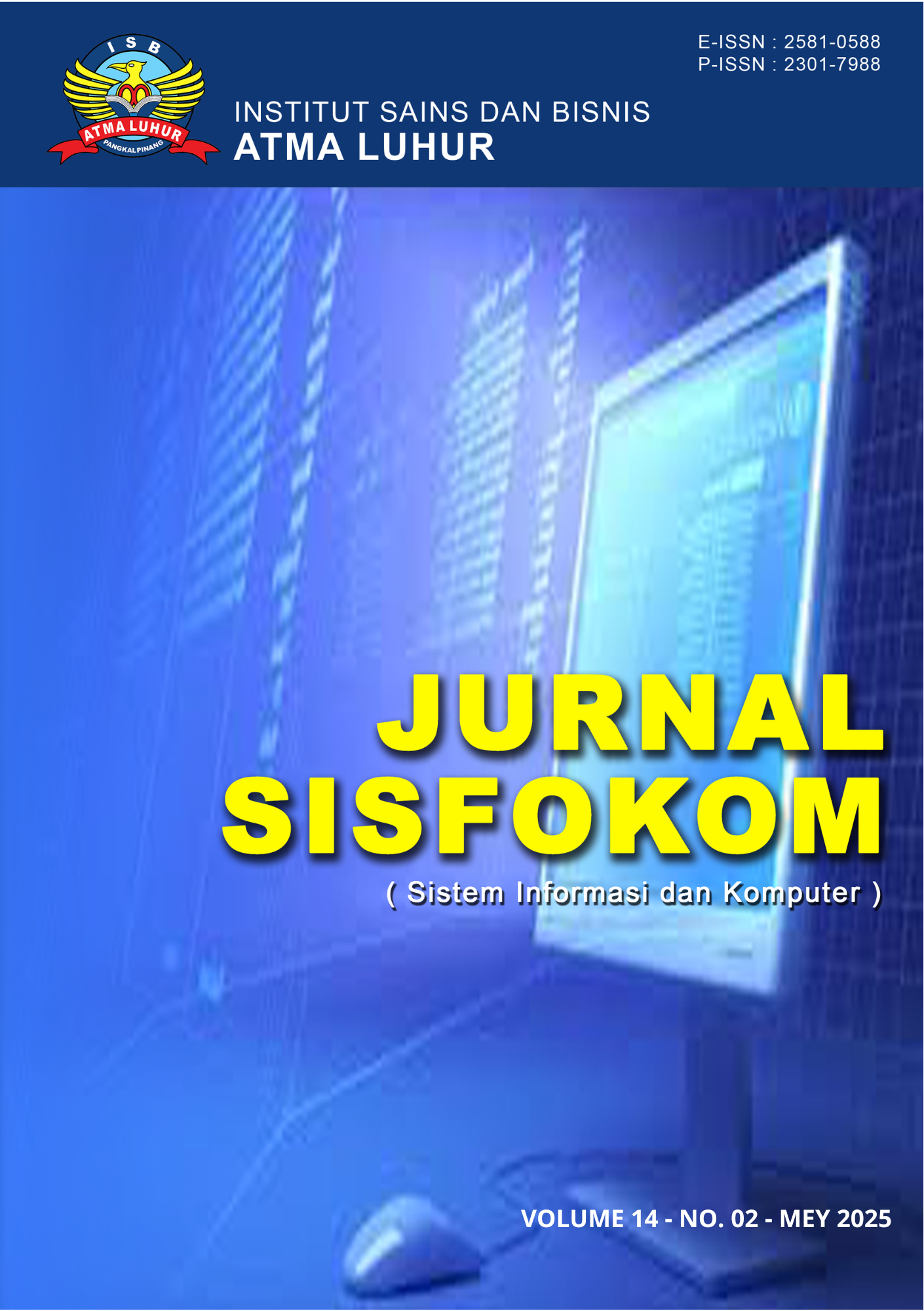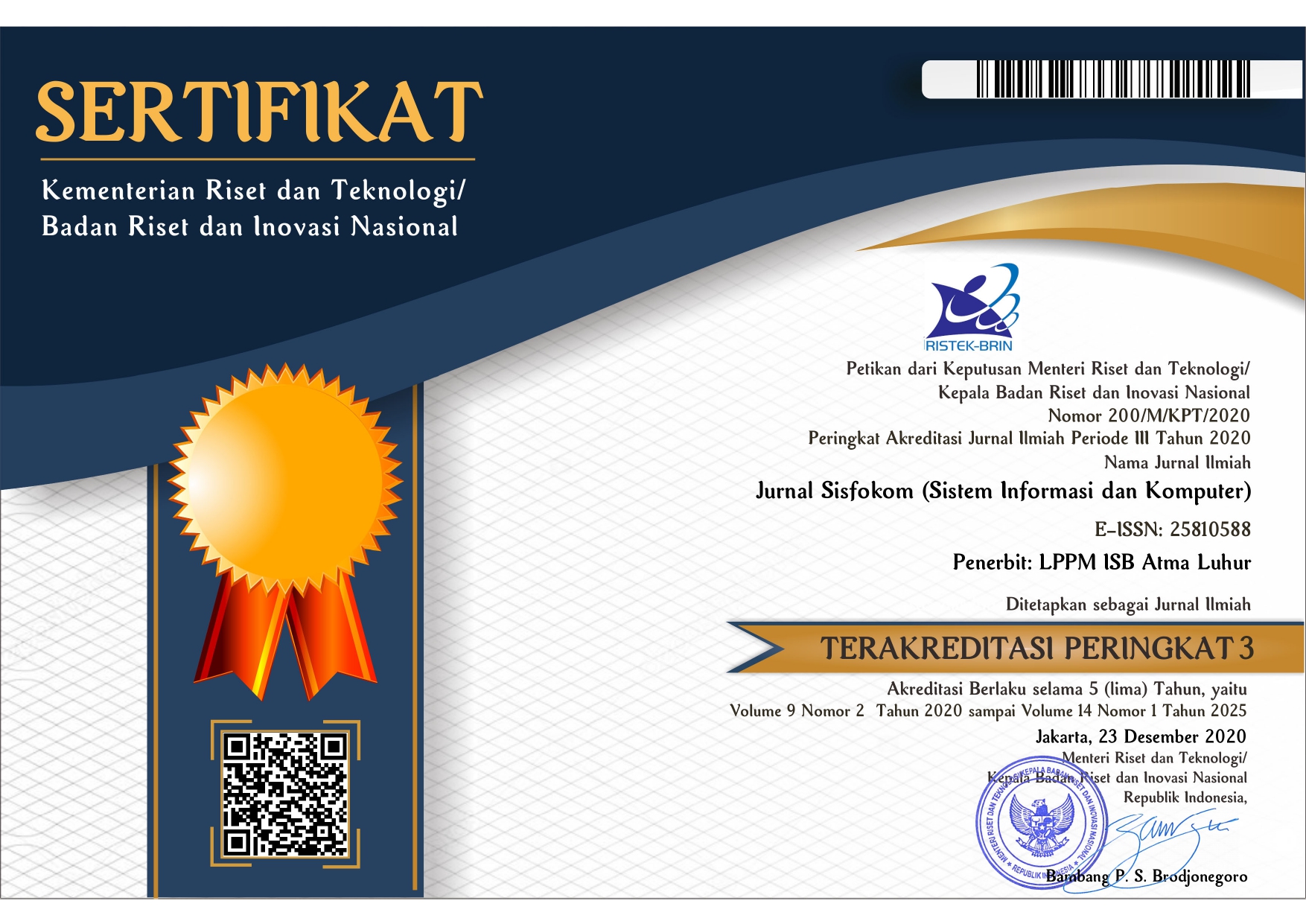Implementation Of Triple Exponential Smoothing Method To Predict Palm Oil Production Of PT.Lonsum Web-Based
DOI:
https://doi.org/10.32736/sisfokom.v14i2.2358Keywords:
Crude Palm Oill , Prediction, Production, Triple Exponential Smoothing, WebsiteAbstract
This research aims to develop a web-based palm oil (CPO) production forecasting system by applying the Triple Exponential Smoothing (TES) method to the production data of PT Lonsum Turangi. The data used includes 60 monthly data from 2020 to 2024. The first 36 data were used for model training, while the remaining 24 data were used for validation. Research instruments included semi-structured interviews and participatory observations to understand the operational patterns and needs of the system in the field. Triple Exponential Smoothing method was chosen for its ability to handle level, trend and seasonal components simultaneously, making it superior to other time series forecasting methods that require large volumes of data. The system was developed using the Rapid Application Development (RAD) method, PHP programming language, and MySQL database. The test results show a good level of prediction accuracy with a Mean Absolute Percentage Error (MAPE) value of 17.34% at an alpha value of 0.1. This system not only improves prediction accuracy, but also provides practical benefits in production planning, meeting market demand, and reducing potential losses due to production imbalances. The novelty of this research lies in the integration of the TES method into a web-based decision support system specific to the CPO industry.References
M. Y. R. Siahaan and D. Darianto, “Karakteristik Koefisien Serap Suara Material Concrete Foam Dicampur Serat Tandan Kosong Kelapa Sawit (TKKS) dengan Metode Impedance Tube,” J. Mech. Eng. Manuf. Mater. Energy, vol. 4, no. 1, pp. 85–93, 2020, doi: 10.31289/jmemme.v4i1.3823.
A. E. Batubara, M. F. Yahya, R. Nasyaa, and P. R. Silalahi, “Analisis Ekspor Impor Kelapa Sawit Indonesia Dalam Meningkatkan Pertumbuhan Ekonomi,” Jurnal Manajemen, 2023.
E. Lette, M. Zunaidi, and W. R. Maya, “Prediksi Penjualan Crude Palm Oil (CPO) Menggunakan Metode Regresi Linear Berganda,” J. Sist. Inf. Triguna Dharma (JURSI TGD), vol. 1, no. 3, p. 128, 2022, doi: 10.53513/jursi.v1i3.5106.
M. I. Wiladibrata, N. Azizah, and K. Rifai, “Smoothing dengan Algoritma Golden Section,” pp. 507–511, 2022.
P. A. Qori, D. S. Oktafani, and I. Kharisudin, “Analisis Peramalan dengan Long Short Term Memory pada Data Kasus Covid-19 di Provinsi Jawa Tengah,” Prism. Pros. Semin. Nas. Mat., vol. 5, pp. 752–758, 2022, [Online]. Available: https://journal.unnes.ac.id/sju/prisma/article/view/54319
M. A. Siregar and N. B. Puspitasari, “Peramalan Hasil Produksi Minyak Kelapa Sawit PT . Bakrie Pasaman Plantations Dengan Metode Holt- Winter ’ S Exponential Smoothing,” Ind. Eng. Online J., vol. 12, no. 2, p. 10, 2023.
Anisah Anisah and Hadita Hadita, “Penerapan Metode Forecasting Dalam Menentukan Persediaan Kopi Susu Pada Usaha Mikro Kecil Menengah Dalam Hal Ini Sir Coffeehouse Bekasi,” J. Manag. Creat. Bus., vol. 2, no. 1, pp. 97–107, Jan. 2024, doi: 10.30640/jmcbus.v2i1.2070.
M. N. Akhtar, E. Ansari, S. S. N. Alhady, and E. Abu Bakar, “Leveraging on Advanced Remote Sensing- and Artificial Intelligence-Based Technologies to Manage Palm Oil Plantation for Current Global Scenario: A Review,” Feb. 01, 2023, MDPI. doi: 10.3390/agriculture13020504.
S. Madianto, E. Utami, and A. D. Hartanto, “Algoritma Triple Exponential Smoothing Untuk Prediksi Trend Turis Pariwisata Jatim Park Batu saat Pandemi Covid-19,” 2021. [Online]. Available: http://jurnal.polibatam.ac.id/index.php/JAIC
J. Ryan and H. Wijaya, “Implementasi Data Mining untuk Sales Forecasting Berbasis Website dengan Metode ARIMA,” bit-Tech, vol. 7, no. 1, pp. 19–27, 2024, doi: 10.32877/bt.v7i1.1332.
R. Nelfi Yolanda, D. Rahmi, A. Kurniati, S. Yuniati, J. H. Pendidikan Matematika Fakultas Tarbiyah dan Keguruan Universitas Islam Negeri Sultan Syarif Kasim Riau Jl Soebrantas NoKm, and T. Karya Kec Tampan Riau, “Penerapan Metode Triple Exponential Smoothing dalam Peramalan Produksi Buah Nenas di Provinsi Riau,” J. Teknol. dan Manaj. Ind. Terap. (JTMIT, vol. 3, no. 1, pp. 1–10, 2024.
R. S. Dewi, I. Jaya, and I. Husein, “Peramalan Penerimaan Pajak Kendaraan Bermotor Menggunakan Metode Triple Exponential Smoothing di Sumatera Utara,” Prox. J. Penelit. Mat. dan Pendidik. Mat., vol. 7, no. 2, pp. 572–583, 2024, doi: 10.30605/proximal.v7i2.3724.
R. A. Sandika, S. K. Gusti, L. Handayani, and S. Ramadhani, “Implementasi Triple Exponential Smoothing dan Double Moving Average Untuk Peramalan Produksi Kernel Kelapa Sawit,” J. Inf. Syst. Res., vol. 4, no. 3, pp. 883–893, 2023, doi: 10.47065/josh.v4i3.3359.
R. B. Saputro, K. P. Kartika, and W. D. Puspitasari, “Implementation of the Triple Exponential Smoothing Method for Predicting Helmet Sales,” JOINCS (Journal Informatics, Network, Comput. Sci., vol. 5, no. 2, pp. 30–34, 2022, doi: 10.21070/joincs.v5i2.1607.
R. N. Puspita, “Peramalan Tingkat Pengangguran Terbuka Provinsi Banten Dengan Metode Triple Exponential Smoothing,” J. Lebesgue J. Ilm. Pendidik. Mat. Mat. dan Stat., vol. 3, no. 2, pp. 358–366, 2022, doi: 10.46306/lb.v3i2.138.
F. Wajdi et al., Metode Penelitian Kuantitatif, vol. 7, no. 2. 2024.
D. Murdiani and M. Sobirin, “Perbandingan Metodologi Waterfall Dan RAD Dalam Pengembangan Sistem Informasi,” JINTEKS (Jurnal Inform. Teknol. dan Sains), vol. 4, no. 4, pp. 302–306, 2022, [Online]. Available: http://www.jurnal.uts.ac.id/index.php/JINTEKS/article/view/2008
Nurman Hidayat and Kusuma Hati, “Penerapan Metode Rapid Application Development (RAD) dalam Rancang Bangun Sistem Informasi Rapor Online (SIRALINE),” J. Sist. Inf., vol. 10, no. 1, pp. 8–17, 2021, doi: 10.51998/jsi.v10i1.352.
A. K. Nalendra, “Rapid Application Development (RAD) model method for creating an agricultural irrigation system based on internet of things,” IOP Conf. Ser. Mater. Sci. Eng., vol. 1098, no. 2, p. 022103, 2021, doi: 10.1088/1757-899x/1098/2/022103.
N. Purwati, O. R. Fadhlurrahman, D. Iswahyuni, S. Kiswati, and H. Faqih, “Sistem Informasi Cuti Karyawan Menggunakan Berbasis Web dengan Metode Rapid Application Development (RAD),” Infomatek, vol. 25, no. 1, pp. 61–68, 2023, doi: 10.23969/infomatek.v25i1.7822.
S. Suendri, T. Triase, and S. Afzalena, “Implementasi Metode Job Order Costing Pada Sistem Informasi Produksi Berbasis Web,” Js (Jurnal Sekolah), vol. 4, no. 2, p. 97, 2021, doi: 10.24114/js.v4i2.17954.
A. Azzahra, W. Ramdhan, and W. M. Kifti, “Single Exponential Smoothing: Metode Peramalan Kebutuhan Vaksin Campak,” Edumatic J. Pendidik. Inform., vol. 6, no. 2, pp. 215–223, 2022, doi: 10.29408/edumatic.v6i2.6299.
A. T. Hidayat, D. P. Sari, and P. Andriani, “Forecasting Penjualan Produk Sembako Menggunakan Metode Triple Exponential Smoothing,” RESOLUSI Rekayasa Tek. Inform. dan Inf. , vol. 4, no. 4, pp. 436–445, 2024, [Online]. Available: https://djournals.com/resolusi
R. F. Putri and E. Ekadiansyah, “Metode Triple Exponential Smoothing Dalam Prediksi Persediaan Bahan Baku Pada PT. Bumi Menara Internusa Berbasis Web,” UNES J. Sci. Res., vol. 3, no. 1, pp. 81–87, 2022.
I. Yulian, D. S. Anggraeni, and Q. Aini, “Penerapan Metode Trend Moment Dalam Forecasting Penjualan Produk CV. Rabbani Asyisa,” J. Teknol. dan Sist. Inf., vol. 6, no. 2, pp. 193–200, 2020.
L. P. Nugraha, R. S. Sianturi, and L. Fanani, “Perancangan Pengalaman Pengguna Aplikasi Knowledge Management System UMKM menggunakan Metode Human Centered Design (Studi Kasus: UMKM Bogor),” J. Pengemb. Teknol. Inf. dan Ilmu Komput., vol. 6, no. 10, pp. 4829–4838, 2022, [Online]. Available: https://j-ptiik.ub.ac.id/index.php/j-ptiik/article/view/11699
F. Oliyan, R. Heriyanto, Y. Septriani, and K. Tania, “Analisis Kebutuhan Pengguna Untuk Perancangan Aplikasi Database Laporan Keuangan Dengan Menggunakan Microsoft Access untuk UMKM,” vol. 3, no. 2, pp. 1–10, 2024.
Downloads
Published
Issue
Section
License

This work is licensed under a Creative Commons Attribution 4.0 International License.
The copyright of the article that accepted for publication shall be assigned to Jurnal Sisfokom (Sistem Informasi dan Komputer) and LPPM ISB Atma Luhur as the publisher of the journal. Copyright includes the right to reproduce and deliver the article in all form and media, including reprints, photographs, microfilms, and any other similar reproductions, as well as translations.
Jurnal Sisfokom (Sistem Informasi dan Komputer), LPPM ISB Atma Luhur, and the Editors make every effort to ensure that no wrong or misleading data, opinions or statements be published in the journal. In any way, the contents of the articles and advertisements published in Jurnal Sisfokom (Sistem Informasi dan Komputer) are the sole and exclusive responsibility of their respective authors.
Jurnal Sisfokom (Sistem Informasi dan Komputer) has full publishing rights to the published articles. Authors are allowed to distribute articles that have been published by sharing the link or DOI of the article. Authors are allowed to use their articles for legal purposes deemed necessary without the written permission of the journal with the initial publication notification from the Jurnal Sisfokom (Sistem Informasi dan Komputer).
The Copyright Transfer Form can be downloaded [Copyright Transfer Form Jurnal Sisfokom (Sistem Informasi dan Komputer).
This agreement is to be signed by at least one of the authors who have obtained the assent of the co-author(s). After submission of this agreement signed by the corresponding author, changes of authorship or in the order of the authors listed will not be accepted. The copyright form should be signed originally, and send it to the Editorial in the form of scanned document to sisfokom@atmaluhur.ac.id.









